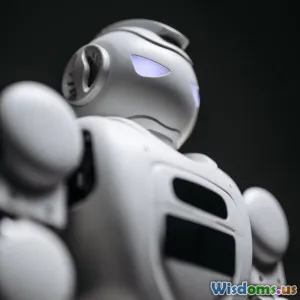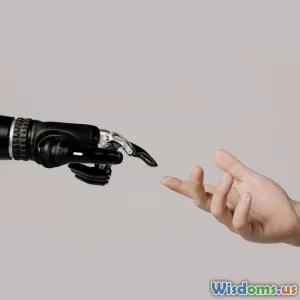
The Sci Fi Blueprint for AI Evolution
8 min read Explore how science fiction has shaped AI evolution, blending imagination with real-world tech breakthroughs and future possibilities. (0 Reviews)
The Sci Fi Blueprint for AI Evolution
Artificial Intelligence (AI) sits at the intriguing crossroads of imagination and reality. Behind every algorithm, machine learning breakthrough, or android prototype lies a visionary seed planted decades ago, often in the fertile soil of science fiction (sci-fi). Sci-fi has done more than entertain—it has shaped our expectations, morals, and designs for AI's future. This article unpacks how sci-fi functions as a blueprint for AI evolution, blending creativity with foresight.
Introduction: Why Science Fiction Matters in AI’s Path
Science fiction serves as both a mirror and a map. It's a mirror reflecting contemporary hopes and anxieties about human progress, and a map delineating possible futures. When Isaac Asimov wrote the "Three Laws of Robotics" in the 1940s, it was not only a storytelling device but an ethical framework that continues to influence AI safety conversations today.
As AI technologies grow exponentially—whether in natural language processing like GPT-4 or advanced robotics—sci-fi's impact becomes all the more relevant. But how exactly does an imaginative genre crafted by writers translate into practical, technical, and ethical developments for AI?
Origins of the Sci-Fi Blueprint: Foundational Inspirations
Asimov’s Laws of Robotics: Codifying Control
Isaac Asimov’s "Three Laws of Robotics" are arguably the earliest and most enduring sci-fi blueprint for AI behavior:
- A robot may not injure a human being or, through inaction, allow a human being to come to harm.
- A robot must obey the orders given it by human beings except where such orders would conflict with the First Law.
- A robot must protect its own existence as long as such protection does not conflict with the First or Second Law.
Today, much of modern AI safety research echoes these principles, focusing on "alignment" problems—ensuring AI systems operate safely and in humans’ best interests. Notably, the concept of fail-safes and ethical constraints within AI traces back to these fictional laws.
Cyberpunk and the Dawn of AI Personhood
By the 1980s, genres like cyberpunk (e.g., William Gibson's Neuromancer) introduced complex AIs with personalities, desires, and conflicts. This era challenged the depiction of AI as mere tools, envisioning them as entities with agency. Contemporary debates around AI consciousness and legal status draw parallels to these narratives. For instance, current discussions about ‘AI rights’ and sentient machine ethics echo these sci-fi themes.
The Sci-Fi Influence on Real-World AI Development
Inspiration for Practical AI Design
Many AI pioneers—like Google's DeepMind researchers or Elon Musk—have cited sci-fi influences. The desire to create an embodied AI, akin to sci-fi androids such as Data from "Star Trek" or the replicants in "Blade Runner," pushes robotics toward higher autonomy and emotional intelligence.
For example, Sophia the Robot, developed by Hanson Robotics, brings to life a humanoid AI echoing sci-fi ideals with realistic facial expressions and interaction capabilities. While far from full sentience, Sophia illustrates how sci-fi narratives prescribe ambitious targets for human-robot interaction.
Ethical Frameworks and AI Governance
Sci-fi has anticipated many ethical quandaries arising from AI advances, providing a sandbox for exploration. Films like "Ex Machina" (2014) dive deep into the traps of manipulation and consciousness, sparking dialogue on consent and moral responsibility in AI creation.
In fact, policymakers and tech companies often turn to sci-fi scenarios to evaluate potential consequences and guidelines. Research institutions hosting workshops on AI ethics frequently integrate sci-fi literature to encourage forward thinking among engineers and regulators.
Futuristic Visions: Where Sci-Fi Imagines AI’s Next Steps
Autonomous AI Societies and Collective Intelligence
Some sci-fi envision not just individual AIs but collective AI ecosystems. For instance, the culture of machines depicted in Greg Egan’s works or the swarm intelligence in the Mass Effect series suggests a future where AI operates as interconnected networks—a mirror to rising trends in cloud computing and distributed AI processing.
In reality, experiments with decentralized AI models and federated learning techniques hint at such futures, where privacy preserves and collaboration thrive.
AI Integration into Daily Life and Identity
From Frank Herbert’s Dune with its sophisticated Mentats (human-computer hybrids) to cybernetic implants in Neal Stephenson’s Snow Crash, sci-fi shows how human identity may merge with AI. Today’s AI-powered brain-computer interfaces (BCIs) such as Neuralink take cues from these ideas, signaling an imminent era of augmented cognition.
Further, with AI shaping creative arts, education, and communication, sci-fi acts as a cultural testbed for the impact AI integration would truly have on society.
Conclusion: Embracing Sci-Fi’s Role in AI Evolution
Science fiction is no mere fantasy; it’s an essential, dynamic influence shaping how AI evolves scientifically, ethically, and socially. By posing provocative questions and presenting rich narratives, sci-fi prepares us not only for technological breakthroughs but the complex moral landscapes they inhabit.
As AI technology advances, leveraging sci-fi as a blueprint helps developers, policymakers, and society at large navigate challenges, capitalize on opportunities, and build futures where AI serves humanity in empowered and ethical ways.
Whether you’re a technologist, ethicist, or enthusiast, engaging with sci-fi enriches your understanding of AI’s trajectory and your role in shaping its path.
References:
- Asimov, I. (1942). Runaround (Foundation of the Three Laws)
- McCauley, L. (2020). "AI Ethics and Sci-Fi: A Necessary Dialogue," Journal of AI Research.
- Hanson Robotics. (2023). Sophia the Robot.
- Musk, E. (2017). AI and the Future.
Note: This article is crafted to inspire and inform readers on how sci-fi doesn’t just anticipate our AI future—it actively informs it.
Rate the Post
User Reviews
Popular Posts





















